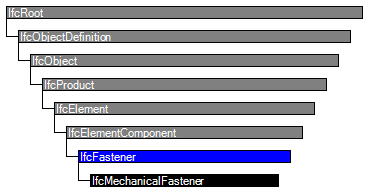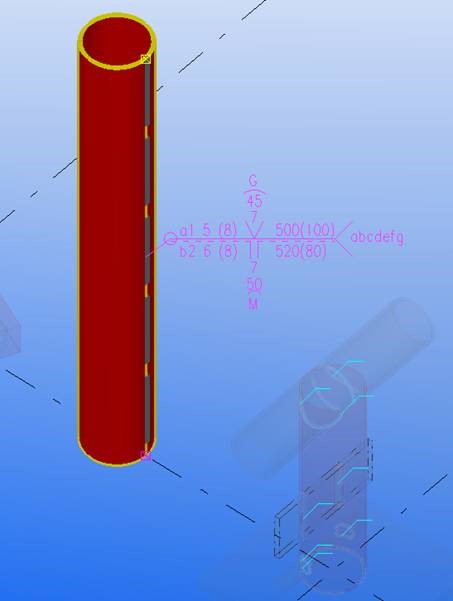Inherited definitions from supertypes
Entity inheritance

Attribute inheritance
| # | Attribute | Type | Cardinality | Description | A |
|---|---|---|---|---|---|
| IfcRoot | |||||
| 1 | GlobalId | IfcGloballyUniqueId | [1:1] | Assignment of a globally unique identifier within the entire software world. | X |
| 2 | OwnerHistory | IfcOwnerHistory | [1:1] | Assignment of the information about the current ownership of that object, including owning actor, application, local identification and information captured about the recent changes of the object, NOTE: only the last modification in stored. | X |
| 3 | Name | IfcLabel | [0:1] | Optional name for use by the participating software systems or users. For some subtypes of IfcRoot the insertion of the Name attribute may be required. This would be enforced by a where rule. | X |
| 4 | Description | IfcText | [0:1] | Optional description, provided for exchanging informative comments. | X |
| IfcObjectDefinition | |||||
| IsDecomposedBy | IfcRelDecomposes @RelatingObject | S[0:?] | Reference to the decomposition relationship, that allows this object to be the composition of other objects. An object can be decomposed by several other objects. | X | |
| Decomposes | IfcRelDecomposes @RelatedObjects | S[0:1] | References to the decomposition relationship, that allows this object to be a part of the decomposition. An object can only be part of a single decomposition (to allow hierarchical strutures only). | X | |
| HasAssociations | IfcRelAssociates @RelatedObjects | S[0:?] | Reference to the relationship objects, that associates external references or other resource definitions to the object.. Examples are the association to library, documentation or classification. | X | |
| IfcObject | |||||
| 5 | ObjectType | IfcLabel | [0:1] |
The type denotes a particular type that indicates the object further. The use has to be established at the level of instantiable subtypes. In particular it holds the user defined type, if the enumeration of the attribute PredefinedType is set to USERDEFINED.
| X |
| IsDefinedBy | IfcRelDefines @RelatedObjects | S[0:?] |
Set of relationships to type or property (statically or dynamically defined) information that further define the object. In case of type information, the associated IfcTypeObject contains the specific information (or type, or style), that is common to all instances of IfcObject referring to the same type.
| X | |
| IfcProduct | |||||
| 6 | ObjectPlacement | IfcObjectPlacement | [0:1] | Placement of the product in space, the placement can either be absolute (relative to the world coordinate system), relative (relative to the object placement of another product), or constraint (e.g. relative to grid axes). It is determined by the various subtypes of IfcObjectPlacement, which includes the axis placement information to determine the transformation for the object coordinate system. | X |
| 7 | Representation | IfcProductRepresentation | [0:1] | Reference to the representations of the product, being either a representation (IfcProductRepresentation) or as a special case a shape representations (IfcProductDefinitionShape). The product definition shape provides for multiple geometric representations of the shape property of the object within the same object coordinate system, defined by the object placement. | X |
| IfcElement | |||||
| 8 | Tag | - | This attribute is out of scope for this model view definition and shall not be set. | ||
| ConnectedTo | IfcRelConnectsElements @RelatingElement | S[0:?] | Reference to the element connection relationship. The relationship then refers to the other element to which this element is connected to. | ||
| HasOpenings | IfcRelVoidsElement @RelatingBuildingElement | S[0:?] | Reference to the Voids Relationship that creates an opening in an element. An element can incorporate zero-to-many openings. | X | |
| IsConnectionRealization | IfcRelConnectsWithRealizingElements @RealizingElements | S[0:?] | Reference to the connection relationship with realizing element. The relationship then refers to the realizing element which provides the physical manifestation of the connection relationship. | X | |
| ConnectedFrom | IfcRelConnectsElements @RelatedElement | S[0:?] | Reference to the element connection relationship. The relationship then refers to the other element that is connected to this element. | X | |
| ContainedInStructure | IfcRelContainedInSpatialStructure @RelatedElements | S[0:1] | Containment relationship to the spatial structure element, to which the element is primarily associated. | X | |
| IfcElementComponent | |||||
| IfcFastener | |||||
Definitions applying to AISC Model View
Concept usage
Properties on Occurrences
The Properties on Occurrences concept applies to this entity as shown in Table 35.
| ||
Table 35 — IfcFastener Properties on Occurrences |
| Exchange | |
|---|---|
| Import | O |
| Export | O |
Placement
The Placement concept applies to this entity.
| Exchange | |
|---|---|
| Import | O |
| Export | O |
Simple Path Geometry
The Simple Path Geometry concept applies to this entity.
Welding path is a theoretical contact line between the two parts to be joined. But it does not need to be precise information and the approximation is acceptable. The Curve for welding path should be either Polyline (IfcPolyline) or Composite Curve (IfcCompositeCurve). Segments of Composit Curve should be Polyline (IfcPolyline), Line (IfcLine), or Trimmed Curve(IfcTrimmedCurve). The Basis Curve of Trimmed Curve should be either Polyine, Line, or Circle (IfcCircle).
| Exchange | |
|---|---|
| Import | O |
| Export | O |
Mapped Geometry
The Mapped Geometry concept applies to this entity.
| Exchange | |
|---|---|
| Import | O |
| Export | O |
Realizing Connection
The Realizing Connection concept applies to this entity.
| Exchange | |
|---|---|
| Import | O |
| Export | O |
Realizing Connection Singular
The Realizing Connection Singular concept applies to this entity.
There are case where weld on one piece a steel plate, which is wrapped to form a circle hollow profile column (see picture below). The seam of the column is welded. This single piece welding utilizes 'Realizing Connection Singular' concept.
| Exchange | |
|---|---|
| Import | O |
| Export | O |
Material Solid
The Material Solid concept applies to this entity.
| Exchange | |
|---|---|
| Import | O |
| Export | O |
Concept inheritance
| # | Concept | Model View |
|---|---|---|
| IfcFastener | ||
| Properties on Occurrences | AISC Model View | |
| Placement | AISC Model View | |
| Simple Path Geometry | AISC Model View | |
| Mapped Geometry | AISC Model View | |
| Realizing Connection | AISC Model View | |
| Realizing Connection Singular | AISC Model View | |
| Material Solid | AISC Model View | |
Formal representations
XSD Specification
<xs:element name="IfcFastener" type="ifc:IfcFastener" substitutionGroup="ifc:IfcElementComponent" nillable="true"/>
<xs:complexType name="IfcFastener">
<xs:complexContent>
<xs:extension base="ifc:IfcElementComponent"/>
</xs:complexContent>
</xs:complexType>
EXPRESS Specification
ENTITY IfcFastener
SUPERTYPE OF(IfcMechanicalFastener)
SUBTYPE OF (IfcElementComponent);
END_ENTITY;
 Instance diagram
Instance diagram Link to this page
Link to this page